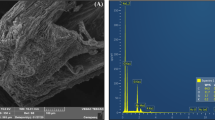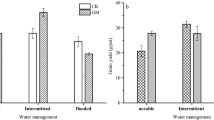Abstract
The effects of sepiolite and biochar on the contents of available nutrients (N, P, and K); the chemical forms and available contents of Cd and Pb in soils; the biomass and growth of maize; and the contents of nutrients, Cd, and Pb in maize were studied in situ in Cd- and Pb-polluted farmlands around the Lanping Pb–Zn mine in Yunnan Province, China. Results demonstrated that sepiolite did not influence the contents of available nutrients in soils, although it significantly increased the pH value and decreased available Cd (CaCl2-extractable and exchangeable) contents and exchangeable and reducible Pb. Moreover, sepiolite increased the biomass in the aboveground part of maize, resulting in the reduction of Cd contents in maize plants and grains by 25.6–47.5%. Meanwhile, the biochar increased the contents of available nutrients in soils and decreased the contents of exchangeable Pb in soils and biomass in the aboveground part of maize plants and grains; decreased the Cd contents in maize stems and grains by 26.7% and 24.6%, respectively; and decreased the Pb content in roots by 16.2%. However, neither sepiolite nor biochar had considerable influence on the Pb content in maize grains. According to a correlation analysis, soil pH has extremely significant negative correlations with available Cd content in soils, which in turn have extremely significant positive correlation with the Cd content in maize plants and grains. These results revealed that sepiolite increases soil pH and decreases Cd bioavailability in farmland soils around the Pb–Zn mine. Furthermore, biochar increases the contents of available nutrients in farmland soils and the maize yield. Sepiolite and biochar both decrease the contents and transfer coefficients of Cd in maize plants and grains and are, thus, applicable to the immobilization remediation of Cd-polluted farmlands.



Similar content being viewed by others
References
Abad-Valle P, Álvarez-Ayuso E, Murciego A, Pellitero E (2016) Assessment of the use of sepiolite amendment to restore heavy metal polluted mine soil. Geoderma 280:57–66
Abid M, Danish S, Zafar-Ul-Hye M, Shaaban M, Iqbal MM, Rehim A, Qayyum MF, Naqqash MN (2017) Biochar increased photosynthetic and accessory pigments in tomato (Solanum lycopersicum L.) plants by reducing cadmium concentration under various irrigation waters. Environ Sci Pollut R 24:22111–22118
Ahmad M, Rajapaksha A, Lim J, Zhang M, Bolan N, Mohan D, Vithanage M, Lee S, Ok Y (2014) Biochar as a sorbent for contaminant management in soil and water: a review. Chemosphere 99:19–33
Ahmad M, Lee S, Lee S, Al-Wabel M, Tsang D, Ok Y (2017) Biochar-induced changes in soil properties affected immobilization/mobilization of metals/metalloids in contaminated soils. J Soils Sediments 17:717–730
Ahmad M, Usman A, Al-Faraj A, Ahmad M, Sallam A, Al-Wabel M (2018) Phosphorus-loaded biochar changes soil heavy metals availability and uptake potential of maize (Zea mays L.) plants. Chemosphere 194:327–339
Bao S (2000) Soil and agricultural chemistry analysis. China Agriculture Press, Beijing
Bian R, Joseph S, Cui L, Pan G, Li L, Liu X, Zhang A, Rutlidge H, Wong S, Chia C, Marjo C, Gong B, Munroe P, Donne S (2014) A three-year experiment confirms continuous immobilization of cadmium and lead in contaminated paddy field with biochar amendment. J Hazard Mater 272:121–128
Bradl H (2004) Adsorption of heavy metal ions on soils and soils constituents. J Colloid Interface Sci 277:1–18
Chen H, Teng Y, Lu S, Wang Y, Wang J (2015) Contamination features and health risk of soil heavy metals in China. Sci Total Environ 512-513:143–153
Cheng J, Li Y, Gao W, Chen Y, Pan W, Lee X, Tang Y (2018) Effects of biochar on Cd and Pb mobility and microbial community composition in a calcareous soil planted with tobacco. Biol Fertil Soils 54:373–383
Cui X, Hao H, Zhang C, He Z, Yang X (2016a) Capacity and mechanisms of ammonium and cadmium sorption on different wetland-plant derived biochars. Sci Total Environ 539:566–575
Cui L, Pan G, Li L, Bian R, Liu X, Yan J, Quan G, Ding C, Chen T, Liu Y, Liu Y, Yin C, Wei C, Yang Y, Hussain Q (2016b) Continuous immobilization of cadmium and lead in biochar amended contaminated paddy soil: a five-year field experiment. Ecol Eng 93:1–8
Duan Q, Lee J, Liu Y, Chen H, Hu H (2016) Distribution of heavy metal pollution in surface soil samples in China: a graphical review. B Environ Contam Tox 97:303–309
Gwenzi W, Muzava M, Mapanda F, Tauro T (2016) Comparative short-term effects of sewage sludge and its biochar on soil properties, maize growth and uptake of nutrients on a tropical clay soil in Zimbabwe. J Integr Agric 15:1395–1406
Hu H, Jin Q, Kavan P (2014) A study of heavy metal pollution in China: current status, pollution-control policies and countermeasures. Sustainability 6:5820–5838
Huang L, Li Y, Zhao M, Chao Y, Qiu R, Yang Y, Wang S (2018) Potential of Cassia alata L. coupled with biochar for heavy metal stabilization in multi-metal mine tailings. Inter J Env Res Pub Heal 15:E494
Jones B, Galan E (1988) Sepiolite and palygorskite. Rev Mineral Geochem 19:631–674
Kocaoba S (2009) Adsorption of Cd(II), Cr(III) and Mn(II) on natural sepiolite. Desalination 244:24–30
Krekeler M, Guggenheim S (2008) Defects in microstructure in palygorskite-sepiolite minerals: a transmission electron microscopy (TEM) study. Appl Clay Sci 39:98–105
Leach D, Song Y, Hou Z (2017) The world-class Jinding Zn–Pb deposit: ore formation in an evaporite dome, Lanping Basin, Yunnan, China. Mineral Deposita 52:281–296
Lehmann J (2007) Bio-energy in the black. Front Ecol Environ 5:381–387
Li J, Xu Y (2018) Effects of clay combined with moisture management on Cd immobilization and fertility index of polluted rice field. Ecotox Environ Safe 158:182–186
Li Z, Ma Z, van der Kuijp TJ, Yuan Z, Huang L (2014) A review of soil heavy metal pollution from mines in China: pollution and health risk assessment. Sci Total Environ 468:843–853
Liang X, Han J, Xu Y, Sun Y, Wang L, Tan X (2014) In situ field-scale remediation of cd polluted paddy soil using sepiolite and palygorskite. Geoderma 235-236:9–18
Liang X, Xu Y, Xu Y, Wang P, Wang L, Sun Y, Huang Q, HUnag R (2016) Two-year stability of immobilization effect of sepiolite on Cd contaminants in paddy soil. Environ Sci Pollut R 23:12922–12931
Liu L, Li W, Song W, Guo M (2018) Remediation techniques for heavy metal-contaminated soils: principles and applicability. Sci Total Environ 633:206–219
Loganathan P, Vigneswaran S, Kandasamy J, Naidu R (2012) Cadmium sorption and desorption in soils: a review. Crit Rev Environ Sci Technol 42:489–533
Lucchini P, Quilliam RS, Deluca TH, Vamerali T, Jones DL (2014) Does biochar application alter heavy metal dynamics in agricultural soil? Agric Ecosyst Environ 184:149–157
Mahar A, Wang P, Li R, Zhang Z (2015) Immobilization of lead and cadmium in contaminated soil using amendments: a review. Pedosphere 25:555–568
Nie C, Yang X, Niazi N, Xu X, Wen Y, Rinklebe J, Ok Y, Xu S, Wang H (2018) Impact of sugarcane bagasse-derived biochar on heavy metal availability and microbial activity: a field study. Chemosphere 200:274–282
O'Connor D, Peng T, Zhang J, Tsang D, Alessi D, Shen Z, Bolan N, Hou D (2018) Biochar application for the remediation of heavy metal polluted land: a review of in situ field trials. Sci Total Environ 619-620:815–826
Quevauviller P, Rauret G, Muntau H, Ure A, Rubio R, López-Sánchez J, Fiedler H, Griepink B (1994) Evaluation of a sequential extraction procedure for the determination of extractable trace metal contents in sediments. Fresenius J Anal Chem 349:808–814
Rizwan M, Ali S, Abbas T, Adrees M, Zia-Ur-Rehman M, Ibrahim M, Abbas F, Qayyum MF, Nawaz R (2018) Residual effects of biochar on growth, photosynthesis and cadmium uptake in rice (Oryza sativa L.) under Cd stress with different water conditions. J Environ Manag 206:676–683
Sui F, Zuo J, Li L, Pan G, Crowley d (2018) Biochar effects on uptake of cadmium and lead by wheat in relation to annual precipitation: a 3-year field study. Environ Sci Pollut R 25:3368–3377
Sun Y, Xu Y, Xu Y, Wang L, Liang X, Li Y (2016a) Reliability and stability of immobilization remediation of Cd polluted soils using sepiolite under pot and field trials. Environ Pollut 208:739–746
Sun Y, Zhao D, Xu Y, Wang L, Liang X, Shen Y (2016b) Effects of sepiolite on stabilization remediation of heavy metal-contaminated soil and its ecological evaluation. Front Env Sci Eng 10:85–92
Sun Y, Sun G, Xu Y, Liu W, Liang X, Wang L (2016c) Evaluation of the effectiveness of sepiolite, bentonite, and phosphate amendments on the stabilization remediation of cadmium-contaminated soils. J Environ Manag 166:204–210
Taylor M, Mould S, Kristensen L, Rouillon M (2014) Environmental arsenic, cadmium and lead dust emissions from metal mine operations: implications for environmental management, monitoring and human health. Environ Res 135:296–303
Uchimiya M, Bannon DI (2013) Solubility of lead and copper in biochar-amended small arms range soils: influence of soil organic carbon and pH. J Agric Food Chem 61:7679–7688
Wang M, Zhu Y, Cheng L, Andserson B, Zhao X, Wang D, Ding A (2018) Review on utilization of biochar for metal-contaminated soil and sediment remediation. J Environ Sci 63:156–173
Wen H, Zhang Y, Cloquet C, Zhu C, Fan H, Luo C (2015) Tracing sources of pollution in soils from the Jinding Pb-Zn mining district in China using cadmium and lead isotopes. Appl Geochem 52:147–154
Xu Y, Liang X, Sun G, Sun Y, Qin X, Wang L (2009) Surface chemical characteristics of sepiolite and their mechanisms of adsorption of Pb2+, Cd2+, and Cu2+. J Agro-Environ Sci 28:2057–2063
Xu Y, Liang X, Xu Y, Qin X, Huang Q, Wang L, Sun Y (2017) Remediation of heavy metal-polluted agricultural soils using clay minerals: a review. Pedosphere 27:193–204
Yang M, Xiao XY, Miao XF, Guo ZH, Wang FY (2012) Effect of amendments on growth and metal uptake of giant reed (Arundo donax L.) grown on soil contaminated by arsenic, cadmium and lead. T Nonferr Metal SOC 22:1462–1469
Yi Q, Dou X, Huang Q, Zhao X (2012) Pollution characteristics of Pb, Zn, As, Cd in the Bijiang river. Procedia Environ Sci 13:43–52
Yin D, Wang X, Chen C, Peng B, Tan C, Li H (2016) Varying effect of biochar on Cd, Pb and As mobility in a multi-metal contaminated paddy soil. Chemosphere 152:196–206
Yin X, Xu Y, Huang R, Huang Q, Xie Z, Cai Y, Liang X (2017) Remediation mechanisms for Cd-contaminated soil using natural sepiolite at the field scale. Environ Sci Proc Impacts 19:1563–1570
Zhang X, Yang L, Li Y, Li H, Wang W, Ye B (2012) Impacts of lead/zinc mining and smelting on the environment and human health in China. Environ Monit Assess 184:2261–2273
Zhao F, Ma Y, Zhu Y, Tang Z, McGrath S (2014) Soil contamination in China: current status and mitigation strategies. Environ Sci Technol 49:750–759
Zhou H, Jiao Y, Shi Z, Ming Q, Wang L, He L (2008) Magnetic analysis and assessment on heavy metal contamination in the farmland soil along Bijiang River in Yunnan Province. J Agro-Environ Sci 27:1586–1591
Funding
This publication is supported by the National Natural Science Foundation of China (41461093, 31560163), the Key Research Development Project in Yunnan Province (2018BB017), the Reserve Talents Fund for Young and Middle-Aged Academic and Technological leaders in Yunnan Province (2018HB043), the Innovation Team for Farmland Non-pollution Production of Yunnan Province (2017HC015), and the Project on Soil Pollution Control and Remediation of Farmland in Lanping County, Yunnan Province (YNBY2016-002).
Author information
Authors and Affiliations
Corresponding authors
Additional information
Responsible editor: Zhihong Xu
Publisher’s Note
Springer Nature remains neutral with regard to jurisdictional claims in published maps and institutional affiliations.
Rights and permissions
About this article
Cite this article
Zhan, F., Zeng, W., Yuan, X. et al. Field experiment on the effects of sepiolite and biochar on the remediation of Cd- and Pb-polluted farmlands around a Pb–Zn mine in Yunnan Province, China. Environ Sci Pollut Res 26, 7743–7751 (2019). https://doi.org/10.1007/s11356-018-04079-w
Received:
Accepted:
Published:
Issue Date:
DOI: https://doi.org/10.1007/s11356-018-04079-w




